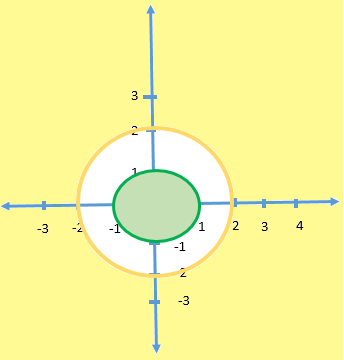
If \[A = \{ (x,y):{x^2} + {y^2} \leqslant 1; x,y \in \mathbb{R}\} \] and $B = \{ (x,y):{x^2} + {y^2} \geqslant 4; x,y \in \mathbb{R}\} $, then find the correct option among the following.
A. $A - B = \phi $
B. $B - A = \phi $
C. $A \cap B \ne \phi $
D. $A \cap B = \phi $
Answer
576k+ views
Hint: We will first draw the boundaries of the circle given to us in the same coordinate axis and then mark the interior or exterior area according to the given data in question and then see if any region coincides or anything. We will then have our answer.
Complete step-by-step answer:
Let us first see the general equation of a circle to know about plotting it better.
The general equation of a circle is given by:- \[{(x - h)^2} + {(y - k)^2} = {r^2}\], where (h, k) is the center of the circle and r is the radius of the circle.
Now, we are given circle boundaries of \[{x^2} + {y^2} = 1\]. Comparing this to general equation, we have:-
Center at (0, 0) and radius of 1.
And we have \[{x^2} + {y^2} = 4\]. Comparing this to general equation, we have:-
Center at (0, 0) and radius of 2.
Drawing these two together in one coordinate axis will look like the figure given below:-

The circle in yellow is \[{x^2} + {y^2} = 4\] and the circle in green is \[{x^2} + {y^2} = 1\].
Now, we will mark the region according to the less than and greater than condition.
To see if we have to take the interior region or the exterior just put the origin in the given equation and if the result is true, we will have to consider the interior region, otherwise the exterior region.
So, putting 0 in \[{x^2} + {y^2} \leqslant 1\], we will get: $0 + 0 \leqslant 1$ that is $0 \leqslant 1$ which is true.
Hence, its interior will be taken.
Now, putting 0 in \[{x^2} + {y^2} \geqslant 4\], we will get: $0 + 0 \geqslant 4$ that is $0 \geqslant 4$ which is absurd.
Hence, its exterior will be taken.
The new graph will be as follows:-

We clearly see that A and B have no region in common as no yellow and green are overlapping or intersecting each other.
So, $A \cap B = \phi $ is true.
So, the correct answer is “Option D”.
Note: If this question is a part of multiple correct, the students might tick option (A) and (B) as well, but you must know that $A - B = A \cap {B^C} = A$ and similarly with the second option.
The students might think that this solution was already clear from the given question. But sometimes due to the interior and exterior region, it may vary.
Complete step-by-step answer:
Let us first see the general equation of a circle to know about plotting it better.
The general equation of a circle is given by:- \[{(x - h)^2} + {(y - k)^2} = {r^2}\], where (h, k) is the center of the circle and r is the radius of the circle.
Now, we are given circle boundaries of \[{x^2} + {y^2} = 1\]. Comparing this to general equation, we have:-
Center at (0, 0) and radius of 1.
And we have \[{x^2} + {y^2} = 4\]. Comparing this to general equation, we have:-
Center at (0, 0) and radius of 2.
Drawing these two together in one coordinate axis will look like the figure given below:-

The circle in yellow is \[{x^2} + {y^2} = 4\] and the circle in green is \[{x^2} + {y^2} = 1\].
Now, we will mark the region according to the less than and greater than condition.
To see if we have to take the interior region or the exterior just put the origin in the given equation and if the result is true, we will have to consider the interior region, otherwise the exterior region.
So, putting 0 in \[{x^2} + {y^2} \leqslant 1\], we will get: $0 + 0 \leqslant 1$ that is $0 \leqslant 1$ which is true.
Hence, its interior will be taken.
Now, putting 0 in \[{x^2} + {y^2} \geqslant 4\], we will get: $0 + 0 \geqslant 4$ that is $0 \geqslant 4$ which is absurd.
Hence, its exterior will be taken.
The new graph will be as follows:-

We clearly see that A and B have no region in common as no yellow and green are overlapping or intersecting each other.
So, $A \cap B = \phi $ is true.
So, the correct answer is “Option D”.
Note: If this question is a part of multiple correct, the students might tick option (A) and (B) as well, but you must know that $A - B = A \cap {B^C} = A$ and similarly with the second option.
The students might think that this solution was already clear from the given question. But sometimes due to the interior and exterior region, it may vary.
Recently Updated Pages
Master Class 8 Maths: Engaging Questions & Answers for Success

Class 8 Question and Answer - Your Ultimate Solutions Guide

Master Class 7 Maths: Engaging Questions & Answers for Success

Class 7 Question and Answer - Your Ultimate Solutions Guide

Master Class 6 Maths: Engaging Questions & Answers for Success

Class 6 Question and Answer - Your Ultimate Solutions Guide

Trending doubts
What is meant by exothermic and endothermic reactions class 11 chemistry CBSE

Which animal has three hearts class 11 biology CBSE

10 examples of friction in our daily life

One Metric ton is equal to kg A 10000 B 1000 C 100 class 11 physics CBSE

1 Quintal is equal to a 110 kg b 10 kg c 100kg d 1000 class 11 physics CBSE

Difference Between Prokaryotic Cells and Eukaryotic Cells




